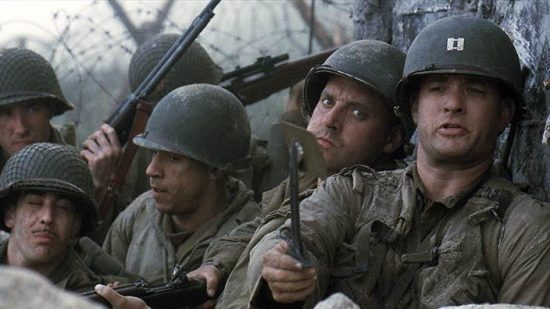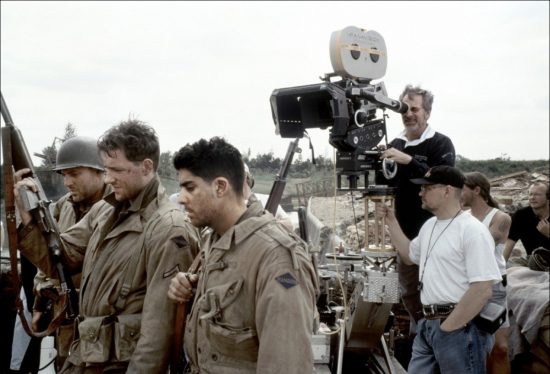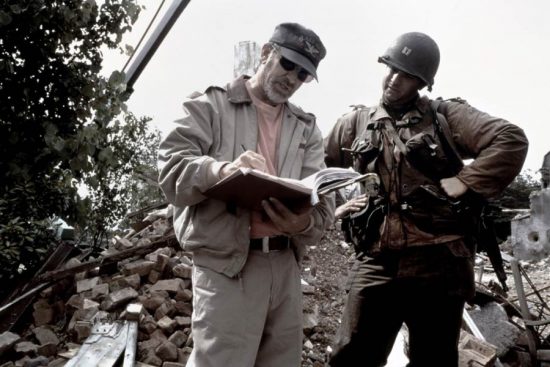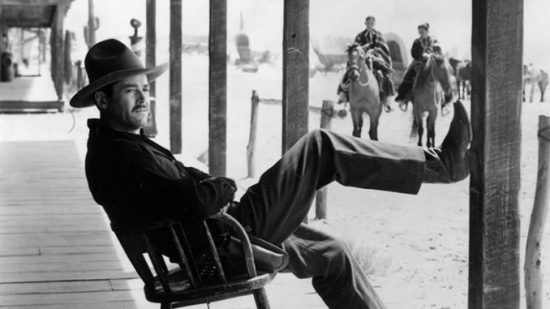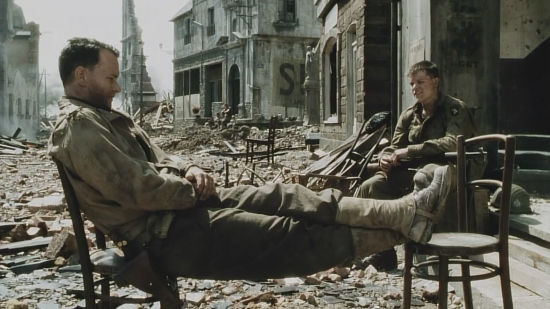SpielBLOG: Saving Private Ryan – A Steven Spielberg Retrospective
The first word of Steven Spielberg’s Saving Private Ryan is ‘Dad!’, as an old man visiting a war cemetery in Normandy is overcome with emotion and staggers, causing concern to his devoted but otherwise mute family. It is the grown son he gets the only line in prologue and it serves as a kind of dedication to Spielberg’s own war veteran father who he would frequently cite as a motivation for doing the film.
Tom Hanks plays United States Army Rangers Captain John H. Miller who along with his squad (Tom Sizemore, Edward Burns, Barry Pepper, Giovanni Ribisi, Vin Diesel, Adam Goldberg, and Jeremy Davies) must search for a paratrooper, Private First Class James Francis Ryan (Matt Damon), the last-surviving brother of four servicemen. But that story only begins after about 27 minutes.
The first half-hour is taken up almost entirely by a graphic depiction of the landing on Omaha Beach. The sequence shows Spielberg at his most innovative. There are obvious influences of the war photography of Robert Capa, but Spielberg and cinematographer Janusz Kamiński de-saturate the picture, cut out frames, underwater shots and even attach a power drill to the side of the camera to give a judder that feels like the machine gun pounding close by. And the sound design is immersive with the pinging on bullets on the metal of the beach defences as well as the explosions and the underwater sound of hearing damaged by a nearby explosion. All of this creates an immersive shock on first viewing, which is hard to recall as much that was new has now become overused and cliched, not only in every war film coming after but also TV series – Band of Brothers deservedly leading the way – and video games.
Narrative slowly emerges from the chaos and characters begin to assert themselves as the squad moves up the beach. The shock for many not only included the visual gore, which Spielberg is adept at – guts hanging out of bodies, a man with his face blown in – but also the sight of American soldiers shooting surrendering Germans and not shooting those who had been caught in the flames of a flamethrowers: ‘Let them burn!’ This was the so-called Good War fought by the Greatest Generation, but red in tooth and claw.
As with Amistad, John Williams’ contribution here signals period portentousness. Every time his brass comes in, it’s easy to feel that we all ought to stand. The West Wing had a similar brass based self-importance. Having immersed us in the subjective experience of the soldiers on the beach to such a terrifying extent, we then go Norman Rockwelling back to America for Captain Exposition to lay down not only the background of the story but also its motivation. Robert Rodat’s screenplay makes a serious error here. The prologue and the war office scenes are utterly unnecessary and didactic. I’d love to see a fan cut that just takes them out. One of the strengths of Dunkirk is the way Nolan keeps to the action of his three strands and doesn’t once cut back to Whitehall or a fearful mother crouched by the wireless.
Once Dennis Farina (the best) has given Hanks his orders, the film gets its Mojo back and Spielberg continues to use impressionistic touches – the rainfall becoming gunfire – to transition from one scene to the other. The sniper scene is a great set-piece and shows how Spielberg will work out ways to show combat without repeating himself. Ted Danson and Paul Giamatti are another two great additions to an amazing cast – we missed Bryan Cranston earlier, but never mind.
The church scene is a quiet moment which gives Spielberg and the actors an opportunity to establish relationships. Tom Sizemore was in the middle of a losing fight with drug addiction at this point, but does some of his best-ever work. The brotherly affection is wonderfully played and Giovanni Ribisi gets a nice moment which will make his subsequent death all the more poignant. But there’s one problem where the script should have been rewritten once Tom Hanks had been cast. Originally, Mel Gibson and Harrison Ford were in the running to play the role and either of those can play grizzled men of war, and it would be a genuine surprise to learn that they were once school teachers, especially Mel. But Tom Hanks is Henry Fonda and Jimmy Stewart rolled into one. He even sits like Fonda in My Darling Clementine at one point. Of course, he taught English composition before the war. It makes total sense. And the mystery built up and surprise at the revelation are both totally bogus.
This is not to say Hanks isn’t good: he is. The moment where he breaks down but tries to hide it from his men is fantastic. It’s just the script needed tweaking to make it more in line with his physical presence.
The finding of Ryan and the battle for the bridge is another sequence that is rightly celebrated. These purely cinematic sequences have the barest of narratives – the Alamo – but within them, there are vignettes of absolute human drama. The whizz-bang combat gives way to the most intimate act of killing, the hand to hand fight that leads to the death of Adam Goldberg’s young Jewish soldier, Private Mellish. I have a friend who recently told me he’d never watch the film again because he couldn’t face that scene.
And yet here something like the Spielberg narrative does finally reassert itself and the final showdown of Captain Miller and the tank has a glimpse of the end of Jaws: ‘Smile you son of a bitch!’
Spielberg has an enduring fascination with World War 2. 1941 to Schindler’s List has seen him use the period with different perspectives and results, but Saving Private Ryan was his most direct depiction up until this point. Along with the TV shows Band of Brothers and to a lesser extent The Pacific, the work popularized the work of historian Stephen Ambrose and led to a resurgence in interest about the period. As we have seen, the film also redefined the genre and specifically the way combat would be depicted for the next decades. Terrence Malick’s The Thin Red Line would come out the same year and in some ways is a deeper film, but Spielberg’s ability to change the way we look at something was once more on display here and Saving Private Ryan should go down as another landmark accomplishment.

